Better Late Than Never: Playoffs Post-mortems
What style of hockey won in the playoffs?
This is very late, but life got in the way for me and delayed my playoff tracking. I moved about a week after the Stanley Cup Final ended & I’ve been preoccupied with getting everything setup at my new place the past month. Free agency happened pretty quickly & I focused a little more on that with the Hurricanes having a busy summer. I’m still a completist and wanted to get the whole thing tracked, but I also wanted there to be a purpose to it rather than tracking the playoffs just to do it. Thankfully, the rest of the playoffs gave me no shortage of things to talk about and some of it is pretty timely because the main team I was dragging on was the Winnipeg Jets, who are the center of a few off-season topics that I wanted to touch on. Those will be coming later this week.
Today, I wanted to go cover some of the overall trends from the playoffs and how it relates to the All Three Zones data. The main point that always gets beaten to death is how tight the playoffs are and how the games are won in the trenches, basically that you can’t win as a rush team. I’m kind of annoyed that is still a talking point because fans & analysts get too hung up on that you need to play one way or another to win. The split in goals scored on the forecheck vs. the rush has always been in the 55-45 range in both the regular season in the playoffs, with the scales tilting more towards the 60/40 range if we include goals scored off faceoffs. That was the case this post-season with 137 of the 329 5v5 goals scored coming off the rush compared to 146 being scored off the forecheck or the cycle, so a 54.8%/45.2% split.
What constitutes as forecheck offense is also kind of a Rorschach test, because it’s usually associated with playing physical in the trenches, while breaking the defense down when you have possession is the bigger part of the puzzle & one that makes or breaks you from becoming a playoff team. There’s a handful of teams that can play off the rush with some of the best in the league (Utah immediately comes to mind), but haven’t quite gotten the balance down of how to score when it becomes a half-rink game and the space is limited. On the flipside, you have teams like Anaheim and Vancouver who wanted to play the heavy territorial game with no rush component and had neutered their own offense. The good teams find the balance & it’s something the two-time champion Florida Panthers have mastered.
I’m going to illustrate this in a series of charts because I think it tells the story well of how they went about their business in the playoffs. Firstly is that they were the most dump-and-chase heavy team in the regular season (they had the lowest Controlled Entry% in the league) and that carried over into the playoffs.
The only team that dumped the puck in more often was their second round opponent in the Toronto Maple Leafs & if you look at the league-wide trends, everyone was under that 50% threshold. The Kings tried to play a more possession-driven game and their numbers are inflated from only playing in one series. After Vegas, there’s a drop-off with most teams falling into that 43-45% range as far as how often they carried the puck in goes. This is the usual case in the playoffs with the main exception being the 2021-22 Colorado Avalanche, who speed-bagged their way to a championship with a Controlled Entry% close to 60. The champs usually set the bar and the Avs haven’t been able to replicate that since their Cup run.
Although an interesting side note is that their opponent, Dallas, had the highest Controlled Entry% in the regular season and even they fell down to the middle of the pack in the playoffs. The Stars run alone is probably a future post on its own from how hit-and-miss they were on a nightly basis. I haven’t seen a team make it that far & have so many games where they were torched at five-on-five from a scoring chance perspective and then showed the ability to counter-punch by dishing it back or winning most of the tight games.
Their change in playing style was definitely influenced from the roster reshuffling they did late in the season. Roope Hintz missed time, Mikael Granlund began playing more and Mikko Rantanen became their centerpiece while Jason Robertson worked his way back into top gear & Miro Heiskanen was on the shelf. There was also an attempt to maybe overcorrect the way they played from the regular season, knowing that the games were about to get tighter and they become less of a one-note team to have success. Similar to what Florida went through with their coaching change, but where they different is that the Panthers could still play off the rush even though it wasn’t their main focus.
This is one of the reasons why I never liked tossing rush offense aside as a non-factor when you get to the playoffs. It’s still part of the game that you have to respect and control to a degree. Florida doesn’t have to put up 30 shots a game off the rush because they’re the best team in the league at preventing transition offense, making it easier for them to go downhill at other teams and giving them some cushion on how they want to play with the puck. You’ll notice that the two lowest producing teams off the rush were New Jersey & Tampa Bay, who faced two of the stingiest defensive teams in the first round, the Lightning having the unfortunate honors of seeing Florida. How they struck off the rush compared to the rest of the league is where things get a little interesting.
Rush Goals by Situation & Context
Something I added to the A3Z data a few years ago was notating where the play started & the context behind it (turnovers vs. plays you make on your own). I haven’t taken the time to really sink my teeth into it yet, there’s been a few things that have been consistent with the preliminary work I’ve done with it. The main one being that most rush offense comes from the defensive zone off controlled exits, it’s the most reliable and repeatable way to attack off the rush. Forcing turnovers high in the zone for counter-attacks give you higher percentage shots but they happen at a lower frequency because of the risky nature behind it. Neutral zone plays make up a smaller chunk of rush offense with the highest percentage plays coming off turnovers & regrouping making up only a small chunk of the pie. Resetting for controlled breakouts & regrouping in the neutral zone typically don’t lead to a lot of goals and it’s becoming more suboptimal for teams to play this way now when you factor in how many more goals & scoring chances happen off turnovers.
The trends in this year’s playoffs backed this up.
Scoring Chance Shooting Percentage & Chance Frequency
Basically the raw data showing what I just explained. The one outlier is the “NZ Recovery” category, which rarely resulted in a scoring chance but the few that occurred ended up in the back of the net. Most scoring chances off the rush had an above average conversion rate with NZ turnovers & DZ counters being the only categories to have a shooting percentage above 10% when going by shots on goal as opposed to shooting percentage.
The frequency of counter-attacks and turnovers is the one thing that did change in the post-season, with defensive zone counters making up 22.7% of scoring chances off the rush in the regular season compared to 17.5% in the playoffs and neutral zone turnovers making up only 14.6% in the playoffs compared to 15.9% in the regular season. Not a huge difference, but incremental things like this add up. What it really means is that this type of offense was impactful, but at more of a premium so if you could a way to break through the defense here, you’re gold. This is where Florida shined.
Florida were the masters at turning defense into offense with their stifling neutral zone play leading to quick-strikes the other way. It’s not a full throwback to the late 90’s, but the same principles are there with not giving anyone an inch of room when they have the puck & using that to explode the other way on the counter-attack. They had different phases to their game, I mentioned in an earlier post that they were an above-average team at controlled breakouts, giving them a different layer to their transition game than other teams that like to play the bumper car style of hockey that dominates the playoffs. They just don’t force much otherwise, which made the rematch against Edmonton a perfect experiment of what happens when the most versatile offense in the league meets the ultimate counter-attack. Ultimately we know which team won that battle, but Florida’s road to Cup number two was an interesting set of trials.
First there was Tampa Bay, who they turned into a one-dimensional group that had to work like hell to get any offense. The Lightning typically don’t mind playing this way and don’t like to regroup in the neutral zone if nothing is open, but Florida got them to play slower and baited them into some bad plays when playing from behind, putting the series out of reach quick.
Next was Toronto, who went against their regular season trends these playoffs and became more of a counter-attack team, especially against the Senators. During the regular season, they leaned more towards regrouping in the neutral zone or picking off zone exits if they were going to carry the puck in, but they were getting most of their offense from 200 feet away in the playoffs, both by forcing turnovers up high and from regular zone exits. They had some success with this against Florida, mainly early in the series and when things got to crunch time in Game 6.
This was a weird series because the Leafs won most of the close games and when they lost, it was ugly. The final two games in Toronto being some of the most lopsided of the playoffs. Not too different from the Dallas/Colorado series, except that Dallas had control when they got back to home ice & that’s where it went off the rails for Toronto. The Panthers scoring on a few point shots also dug the hole further, but the margins are also very thin in the playoffs & it doesn’t take much for the script to get flipped on you. Even a dominant team like Florida is going to give you a couple of chances a game and Toronto had a couple of early opportunities in Games 5 & 7 on breakaways that they didn’t score on. Once they fell behind, the Leafs went back to trying to play the controlled, methodical game in the neutral zone and that fed into what the Panthers wanted to do, which led to the doom spiral on home ice.
Carolina’s profile is similar to the Panthers, with main difference being that the Hurricanes don’t try to force plays out of the defensive zone instead of the neutral zone. Florida went to school on this early, forcing turnovers on forecheck and making the Canes get outside their comfort zone. It then spilled over to other parts of Carolina’s game and the floodgates eventually opened up in Games 2 & 3 with Florida not giving up any chances & caving in the team that is used to dominating the territorial game. I talked about this in my series recap here so I’m just going to direct you to that to save space & move onto the Final.
Then came the Oilers, who had the most versatile offensive profile in the playoffs, mostly thanks to McDavid playing out of his mind in the first three rounds and Bouchard acting as a one-man breakout. Most teams are going to try to avoid taking risks and turning the puck over against the Panthers, so the Oilers were a different animal because they’re going to try to break through the Panthers structure and had the talent to do it. This is what made it an oil vs. water test (no pun intended) and Edmonton had some success with it early in the series.
Prior to this series, Florida surrendered only four goals off of neutral zone reloads all playoffs, two of them coming against Carolina and had yet to surrnder a goal off a controlled breakout or a regroup in the neutral zone. Edmonton had scored seven goals all playoffs off those situations, so getting any advantage here could have tilted the series in their favor. Where they fell short, however, was the counter-attack game.
As good as the Oilers are in transition, they only scored four goals off a counter-attack or a neutral zone turnover. Meaning that if they were getting any goals off the rush, they were coming off plays that they had to setup more methodically or when they could get a successful breakout against a forecheck. Not having to rely on turnover for your offense is usually a good thing because Florida isn’t going to give you a lot of those per game, but the type of offense the Oilers like to play is very hard to execute against the Panthers, so the games were going to be a struggle if their top guys were off their games even just a little bit.
I talked about this in my game recaps from the SCF, but what happened in Game 5 illustrates it best. The Oilers can really put the hurt on you when they can break the puck out with control, Florida’s forecheck was eating them alive and preventing them from doing that & even Bouchard was struggling because Florida kept isolating him when he had to retrieve pucks, giving him no outlets and nowhere to go except off the glass. Florida didn’t need to play with the puck or cycle much in Edmonton’s zone so they could just pressure them and get back into defensive posture, making the Oilers regroup or go through an impossible forecheck to get any offense, which fed right into how they like to play and it all came to ahead in Game 6 where the Panthers scored three goals in the first period off neutral zone turnovers.
The rush might not be how the Panthers play most of their games, but it’s a major part in how they win and it’s connected to how they play in the other two zones. An interesting sidenote of how it relates to their roster construction is that 6 of their 22 goals off the rush were scored by Sam Bennett, who also ccounted for 12% of their shots on goal that were off the rush. Another three were scored by Brad Marchand and he assisted on another one while contributing to 24 shots overall. His center, Anton Lundell, didn’t score a goal off the rush but assisted on four and contributed to 26 shots. Right behind them was Eetu Luostarinen with 20 shot contributions off the rush, two of them being goals and four of them being assists. Absent from this list is Sam Reinhart and Sasha Barkov, who scored all 11 of their five-on-five goals off the cycle or the forecheck.
This is the balance you’re looking for when building a top team. Florida’s top guys can contribute off the rush, but they didn’t have to in this run & they build their other two lines around guys who can play with more speed & strike the other way when they get a turnover. Bennett has been the one guy with the green light to do this since Florida made their coaching change & Marchand has been one of the best in the league at going coast-to-coast for his entire career. Your checking line doesn’t always have to play like this to win, but it is a nice element to have when your top guys are playing more of the half-rink game. Luostarinen & Lundell are defensive-minded forwards who can play the possession game and even some of their lower line guys like Jesper Boqvist can play this way.
Rush offense might be only 45% of the game, but it’s a part you can’t ignore and Florida’s mastered the balance of having it complement their primary forechecking game.
Upcoming Posts:
Looking at the other 55% with forecheck/cycle offense.
Ehlers playoff run & his linemates with the Jets
Gabriel Vilardi & Dylan Samberg’s playoff run & RFA deals
Sheltered defensemen elevated to big roles

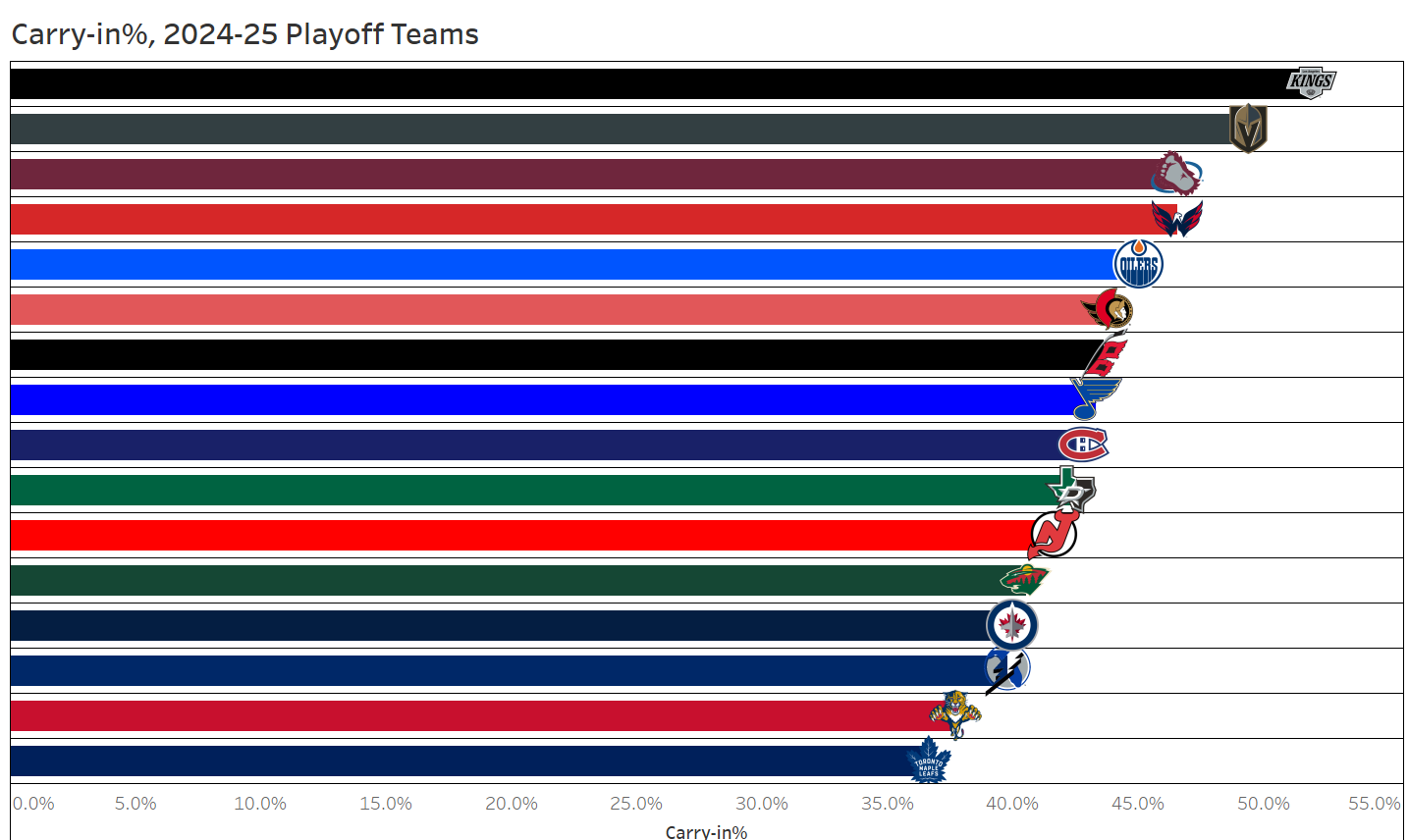
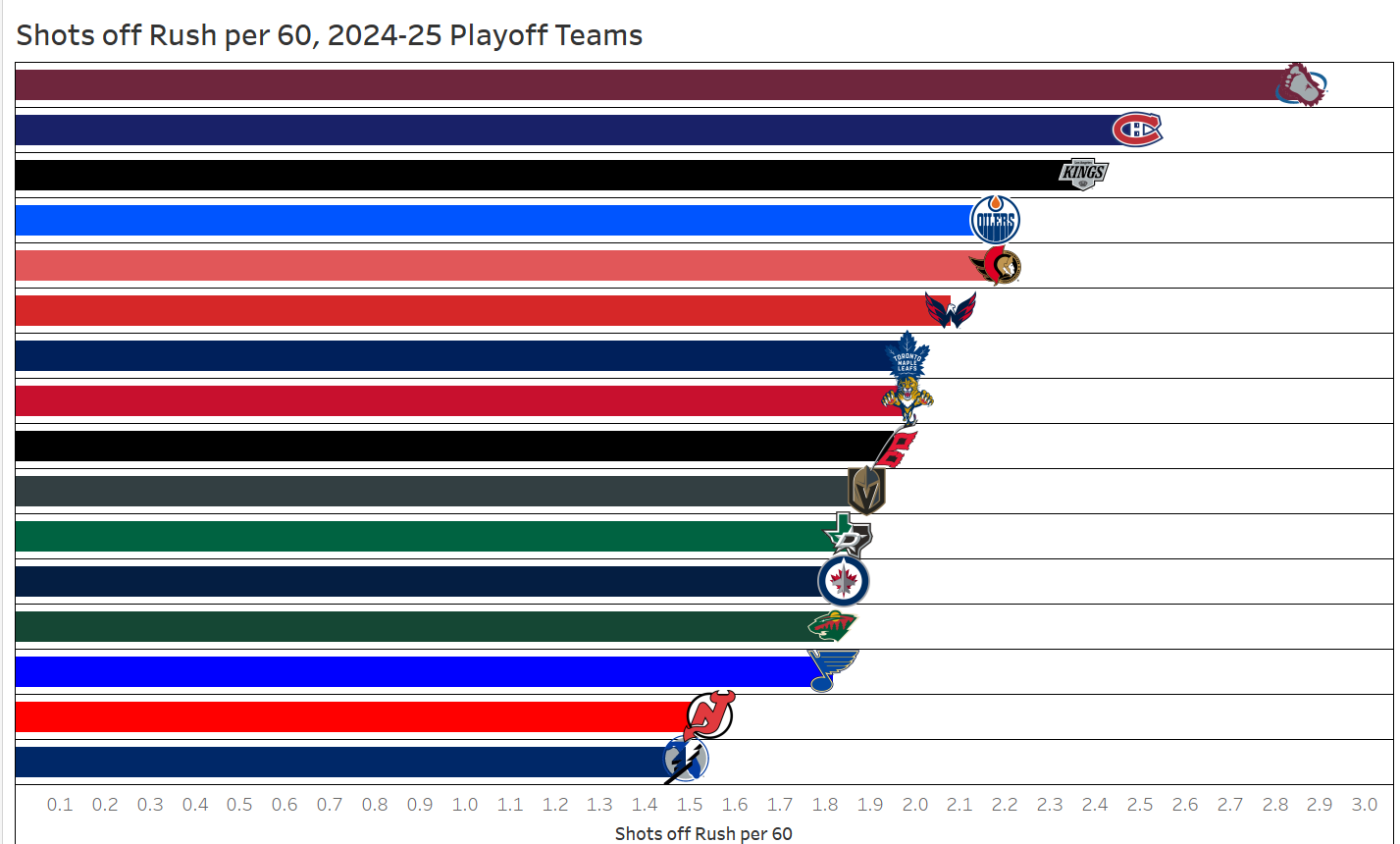
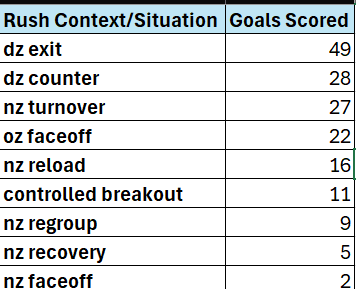
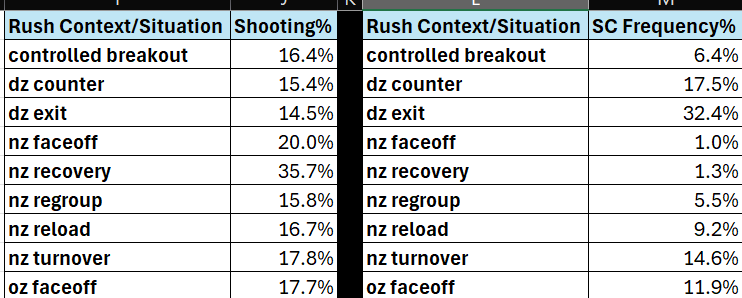
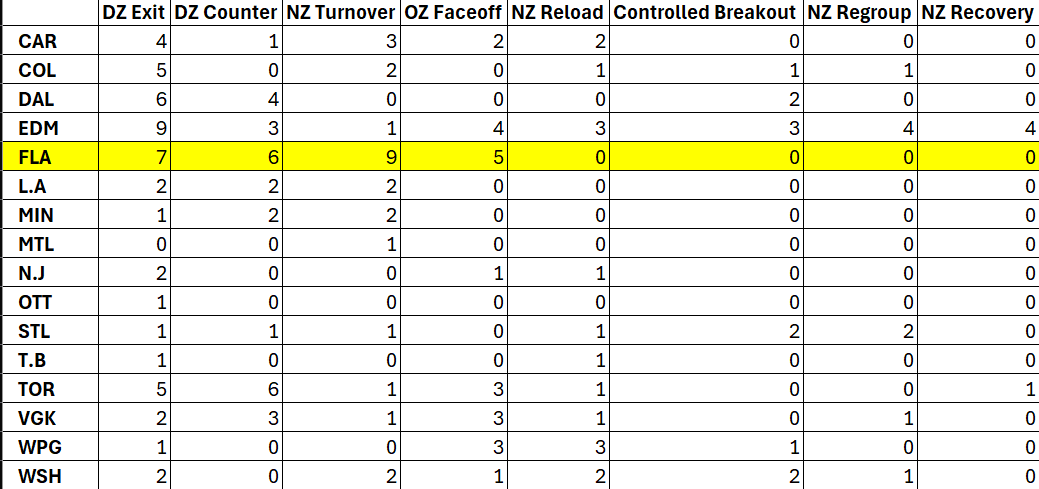
Great article. I think with the Panthers breaking so many brains this off-season every analysis, no matter how “late” is certainly welcome.
I also appreciate your perspective on the Leafs’ game 5 and 7 defeats: their nature as blowouts and folks suggesting that, as such, they constitute the “most embarrassing defeat” of the Matthews era are alarmist and incredibly myopic — seeing the plethora of goals against, not as lack of effort, but the top guns being forced to take risks at a higher rate to generate… frankly anything at all against a team that was metaphorically choking them out. Watching the games and tracking some macro stats , I felt as though the Defence was largely to blame for not allowing the Leafs’ forward talent to generate sufficient danger and allowing themselves to get consistently bogged down.
My question for you is how comfortable should the Leafs be with their current D and should they prioritize finding a puck over another middle-6 forward?
Thanks for the article. Wanted to know your thoughts on a related subject. I was perusing the NHL Edge team data, and one interesting Florida stat that popped out was their total skating distance. In the regular season, the Florida Panthers were in the 96th percentile in skating distance with 15.28 km/ 60 min (5v5). This, combined with their 1-2-2 Forecheck system it makes you wonder what types of adjustments teams will need to make against such aggression. What's your analysis on why they are outskating every other team? Is it a reflection of their system or their conditioning? Could this explain why their NZ turnover number is so high?